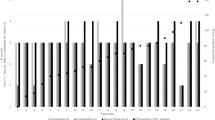Abstract
Purpose
We evaluated the long-term results of aortic valve replacement for bicuspid aortic valve patients with or without surgical treatment of the ascending aorta.
Methods
A total of 145 bicuspid aortic valve patients had undergone aortic valve replacement since 1974 at our institution. No surgical treatment (Group-N; n = 115) was performed in the ascending aorta if the diameter was less than 40 mm. We wrapped an ascending aorta of 40–50 mm with an artificial graft (Group-W; n = 19), and performed replacement (Group-R; n = 11) if the ascending aorta measured more than 50 mm. Follow-up was completed for 144 patients (99.3 % of the cases).
Results
The hospital mortality rate was 1.4 %. There were no significant differences among Groups N, W and R in the freedom from valve-related death and cardiac death at 10 years after surgery. The rates of freedom from aorta-related events in the three groups at 10 years after surgery were 98.3 % (Group-N), 100 % (Group-W) and 100 % (Group-R).
Conclusions
The long-term survival was equivalent among the three groups, and the rates of freedom from aorta-related death or events were low. Our surgical protocol for the treatment of the enlarged ascending aorta associated with BAV is appropriate.


Similar content being viewed by others
References
Siu SC, Silversides CK. Bicuspid aortic valve disease. J Am Coll Cardiol. 2010;55(25):2789–800.
Fedak PWM, et al. Clinical and pathophysiological implications of a bicuspid aortic valve. Circulation. 2002;106(8):900–4.
Robicsek F, et al. The congenitally bicuspid aortic valve: how does it function? Why does it fail? Ann Thorac Surg. 2004;77(1):177–85.
Novaro GM, et al. Features and predictors of ascending aortic dilatation in association with a congenital bicuspid aortic valve. Am J Cardiol. 2003;92(1):99–101.
Fedak PWM, et al. Vascular matrix remodeling in patients with bicuspid aortic valve malformations: implications for aortic dilatation. J Thorac Cardiovasc Surg. 2003;126(3):797–805.
Ikonomidis JS, et al. Aortic dilatation with bicuspid aortic valves: cusp fusion correlates to matrix metalloproteinases and inhibitors. Ann Thorac Surg. 2012;93(2):457–63.
Hiratzka LF, et al. 2010 ACCF/AHA/AATS/ACR/ASA/SCA/SCAI/SIR/STS/SVM guidelines for the diagnosis and management of patients with thoracic aortic disease: executive summary. A report of the American college of cardiology foundation/American heart association task force on practice guidelines, American Association for thoracic surgery, american college of radiology, American stroke association, society of cardiovascular anesthesiologists, society for cardiovascular angiography and interventions, society of interventional radiology, society of thoracic surgeons, and society for vascular medicine. Catheter Cardiovasc Interv. 2010;76(2):E43–86.
Nishida T, Tominaga R. A look at recent improvements in the durability of tissue valves. Gen Thorac Cardiovasc Surg. 2013;61(4):182–90.
Nishida T, et al. Long-term results of aortic valve replacement with mechanical prosthesis or carpentier-edwards perimount bioprosthesis in Japanese patients according to age. Circ J. 2014;78(11):2688–95.
Nishida T, et al. More than 20-year experience of Bentall operation with mechanical prostheses for chronic aortic root aneurysm. Gen Thorac Cardiovasc Surg. 2015;63(2):78–85.
Piazza N, et al. Guidelines for reporting mortality and morbidity after cardiac valve interventions–need for a reappraisal? Ann Thorac Surg. 2009;87(2):357–8 (discussion 359–60).
Edwards WD, Leaf DS, Edwards JE. Dissecting aortic aneurysm associated with congenital bicuspid aortic valve. Circulation. 1978;57(5):1022–5.
Michelena HI, et al. Incidence of aortic complications in patients with bicuspid aortic valves. JAMA. 2011;306(10):1104–12.
Tzemos N, et al. Outcomes in adults with bicuspid aortic valves. JAMA. 2008;300(11):1317–25.
Borger MA, et al. Should the ascending aorta be replaced more frequently in patients with bicuspid aortic valve disease? J Thorac Cardiovasc Surg. 2004;128(5):677–83.
Cozijnsen L, et al. What is new in dilatation of the ascending aorta? Review of current literature and practical advice for the cardiologist. Circulation. 2011;123(8):924–8.
Girdauskas E, et al. Risk of late aortic events after an isolated aortic valve replacement for bicuspid aortic valve stenosis with concomitant ascending aortic dilation. Eur J Cardiothorac Surg. 2012;42(5):832–7 (discussion 837–8).
Kim YG, et al. Aortopathy and bicuspid aortic valve: haemodynamic burden is main contributor to aortic dilatation. Heart. 2012;98(24):1822–7.
Lee SH, et al. Management of dilated ascending aorta during aortic valve replacement: valve replacement alone versus aorta wrapping versus aorta replacement. J Thorac Cardiovasc Surg. 2013;146(4):802–9.
Nishi H, et al. Factors affecting a dilated ascending aorta in patients with bicuspid aortic valve: the relevance of valve anatomy, body size and age. Surg Today. 2014;44(8):1483–9.
Yasuda H, et al. Failure to prevent progressive dilation of ascending aorta by aortic valve replacement in patients with bicuspid aortic valve: comparison with tricuspid aortic valve. Circulation. 2003;108(Suppl 1):II291–4.
Sawa Y. Transcatheter aortic valve implantation. Surg Today. 2015;45(5):527–36.
Author information
Authors and Affiliations
Corresponding author
Ethics declarations
Conflict of interest
The authors declare that they have no conflicts of interest.
Rights and permissions
About this article
Cite this article
Matsuyama, S., Nishida, T., Ushijima, T. et al. Long-term results after treatment of the ascending aorta for bicuspid aortic valve patients. Surg Today 46, 729–734 (2016). https://doi.org/10.1007/s00595-015-1274-4
Received:
Accepted:
Published:
Issue Date:
DOI: https://doi.org/10.1007/s00595-015-1274-4




